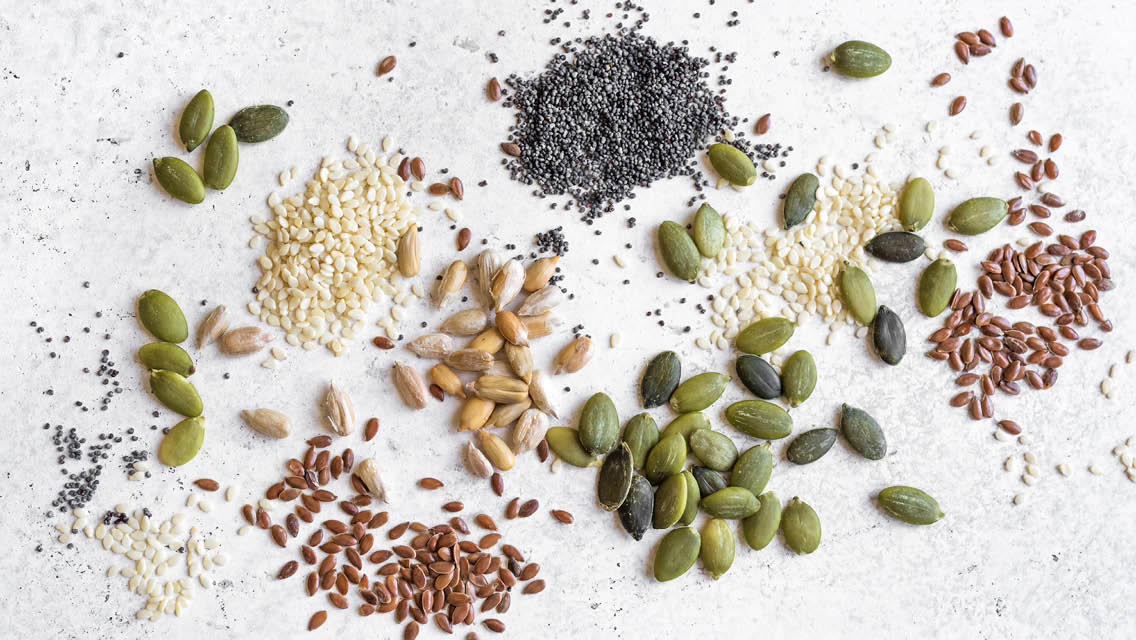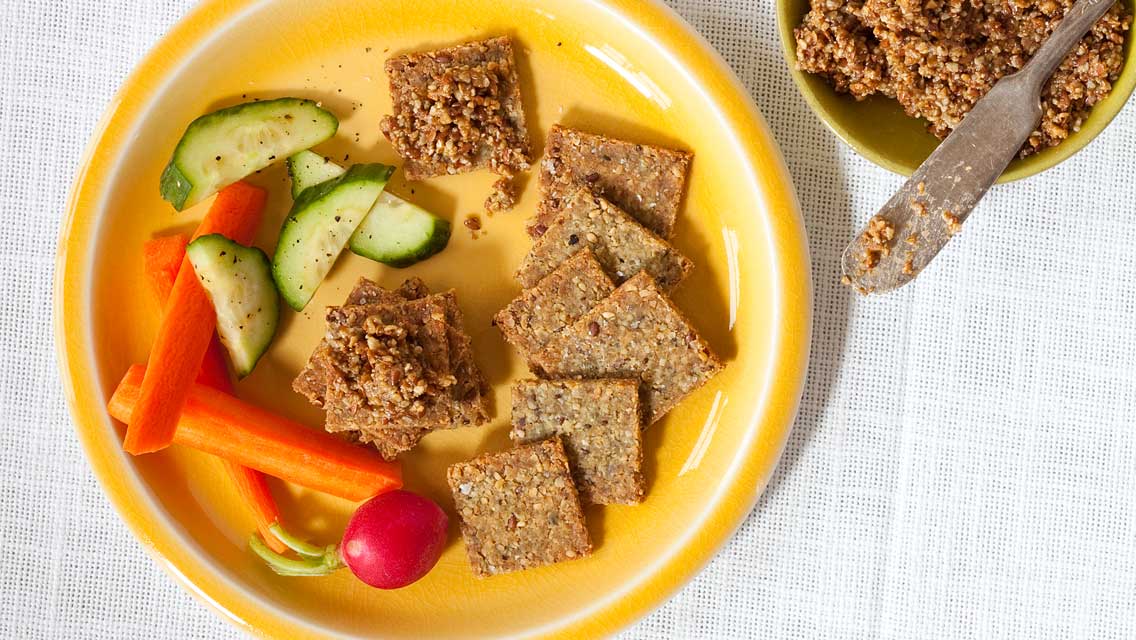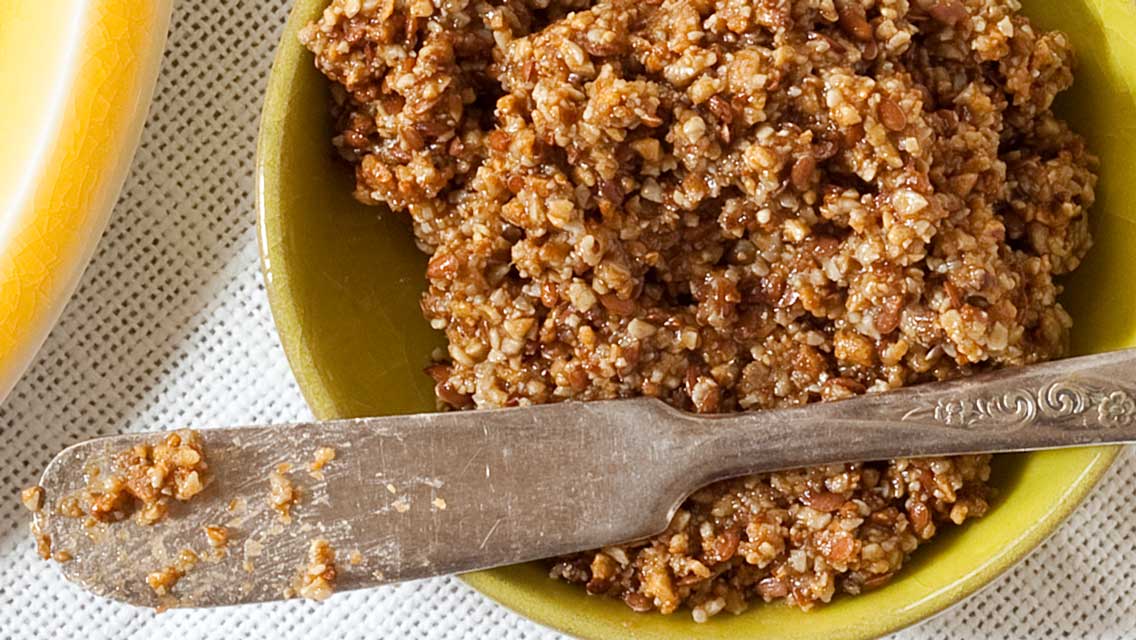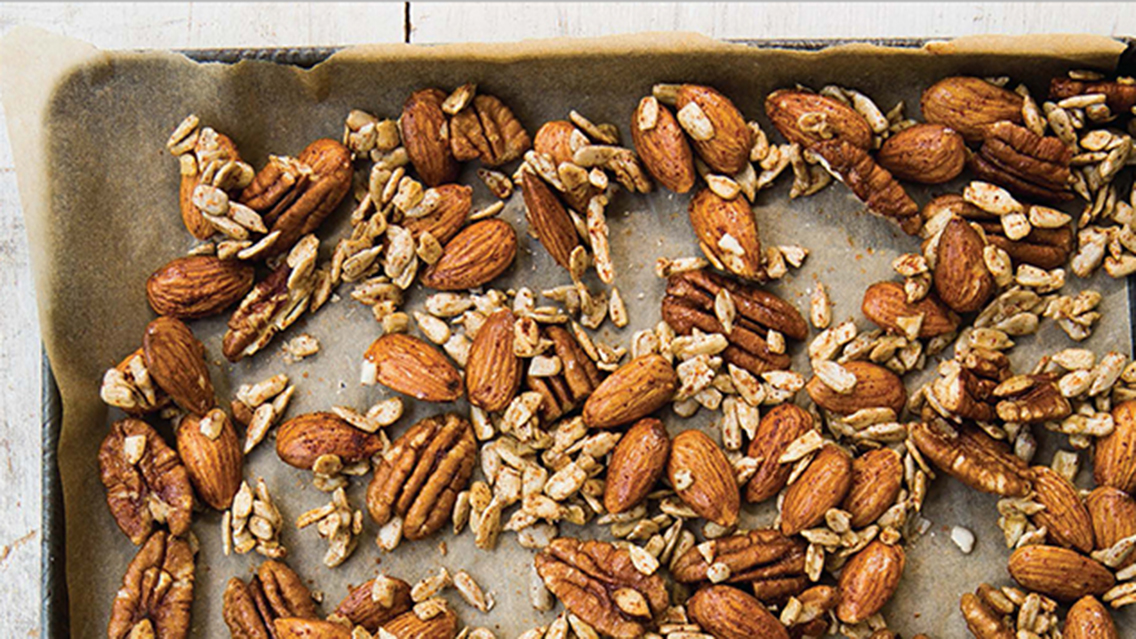All grains and nuts are seeds, and five edible seeds are especially potent. They may be small, but don’t equate size with stature. Pumpkin seeds, hemp seeds, flaxseeds, sesame seeds, and chia seeds all punch far above their weight in nutritional value.
They’re excellent sources of phytosterols, plant compounds that boost heart health. Many of them have potent antioxidant power, and they all supply ample fiber and protein. Each has its own unique nutrient profile and offers myriad health benefits.
For example, chia seeds feature anti-aging, anticancer, anti-inflammatory, antioxidant, antidepressant, and antianxiety properties, according to a 2016 study. They help to prevent blood clots, fight type 2 diabetes, reduce hypertension, and boost ocular and immune health.
“As the source of plant life, seeds contain nutrients in a concentrated way to sprout and nourish a seedling,” says clinical nutritionist Liz Lipski, PhD, author of Digestive Wellness. “They are loaded with fatty acids, amino acids, vitamins, minerals, and fiber. They are tiny, nutrient-dense packages.”
Functional-medicine practitioner Deanna Minich, PhD, believes seeds are one of nature’s most well-rounded whole foods. “What I most like about them is that they are a complete food as a storehouse of vitamins, minerals, protein, fibers, and fats,” she says.
And they’re versatile. “Seeds fit into many different applications, from smoothies to stir-fries.”
They are also one of our earliest food sources. Dental records show that our prehistoric ancestors had teeth hard enough to grind even the shells of nuts and seeds. And humans were grinding oats (a grass seed) into flour as early as 30,000 years ago.
Seeds still support our health today. Learn more about these five superfood seeds and how you can enjoy them more often.
1. Chia Seeds
Native to the regions now known as Mexico and Guatemala, chia seeds have been cultivated for human consumption for more than five millennia. Early Aztec and Mayan cultures used chia in folk medicine and cosmetics, and offered it to the gods in religious ceremonies. They viewed it as a source of strength and vigor, a tiny food worthy of divine appreciation.
“Chia may be tiny, but these little seeds pack a powerful nutritional punch,” says Lipski. “Their popularity has skyrocketed over the past decade, in part due to their nutrient density and in part because they are extremely versatile as a functional food.”
Nutritional Profile
“Chia seeds will significantly boost the nutritional value of whatever you choose to make with them,” says Lipski. These seeds are 40 percent fiber by weight, and a 1-ounce serving — about 3 tablespoons — boasts 11 grams of fiber.
That could be a windfall for fiber-starved Americans: The average U.S. adult consumes only 10 to 15 grams of fiber per day, while the USDA recommends about twice that; some functional-medicine practitioners believe 50 grams daily is ideal.
Research suggests that adequate fiber intake significantly lowers the risk for developing heart disease, hypertension, type 2 diabetes, obesity, stroke, and certain gastrointestinal diseases.
Chia seeds contain both insoluble and soluble fiber, which helps balance blood sugar, stabilize insulin, and support healthy elimination. The soluble fiber in each seed can also absorb up to 12 times its weight in water. This expansion promotes feelings of satiety.The fiber also helps feed beneficial gut bacteria.
A 1-ounce serving of chia seeds contains 4 grams of protein and all nine amino acids, which makes them a complete protein, good for building and maintaining muscle and great for plant-based eaters looking to add more protein to their diet. It also has 9 grams of fat, half of which is alpha-linolenic acid (ALA), an anti-inflammatory omega-3 fatty acid.
Chia seeds are brimming with antioxidants that offset oxidative stress, as well as minerals that support bone health, including manganese, phosphorus, and calcium.
How to Eat Chia Seeds
They are especially good in smoothies or as the base for easy puddings. Mix into hot or cold cereal, add to yogurt, or use to make jam. Their capacity to absorb liquid makes them great for thickening sauces. They also may be used in place of an egg in baking.
Chia can be eaten dry and whole, but soaking them makes the nutrients more bioavailable. Soaked chia seeds are also easier to eat. Raw chia can get stuck in your teeth — which isn’t harmful but can be annoying.
(Try them in these creamy and sweet DIY ice pops.)
2. Hemp Seeds
Hemp is used to make rope, paper, and clothes, and humans have consumed its seeds for centuries. Still, hemp production was outlawed in the United States in 1970 as part of the Controlled Substances Act, thanks to its botanical proximity to cannabis. (The seeds contain only benign traces of THC.) Hemp was fully legalized in 2018, and it’s now much easier to find hemp seeds stateside.
Because hemp is an environmentally friendly crop, its seeds are a truly sustainable form of protein. Like chia, they’re a complete protein and require far less water to produce than animal protein or other plant-based sources like almonds.
Hemp is naturally pest-resistant, and its deep roots nourish the soil. These roots may also help trap carbon dioxide from the atmosphere in a beneficial process known as carbon sequestration.
Nutritional Profile
Hemp seeds are 25 percent protein, and they contain all nine amino acids. Their oil is rich in essential fatty acids, including the omega-3 ALA and the omega-6 gamma-linolenic acid (GLA).
GLA, like ALA, is also anti-inflammatory. Many experts consider the ratio of omega-6s to omega-3s in hemp-seed oil — between 2:1 and 3:1 — optimal for human health.
Like chia, hemp seeds contain phytosterols, which studies suggest may improve heart health, and they deliver plenty of fiber as well. They’re also an excellent source of magnesium, which supports a wide range of internal functions, from bolstering the adrenal glands to promoting muscle relaxation.
The protein in hemp seeds is more digestible than the protein found in many grains, nuts, and legumes. As a complete protein, these seeds may be especially valuable for vegans and vegetarians.
“Hemp seeds are one of my favorites,” says functional-medicine expert Will Cole, DC. Their nutritional profile makes them “important for optimal hormone and brain health, as well as a great source of fiber for microbiome diversity and digestive health.” Be sure to seek out whole seeds rather than hemp hearts, which are hulled and don’t have the fiber of the whole seed.
How to Eat Hemp Seeds
With a nutty, earthy flavor, hemp seeds add a nice crunch to salads or yogurt. Grind them into a protein powder, or use whole seeds in place of breadcrumbs to make gluten-free fried chicken or fish.
Blend them into smoothies; with water to make seed milk; or in a food processer to make hemp butter. A light toasting brings out even more of their nutty flavor.
Hemp seeds are sensitive to heat and light, so store them in the fridge. And avoid cooking with hemp-seed oil: You’ll get the best nutritional value from the oil if you use it fresh to make dressings or finish dishes.
3. Flaxseeds
Humans have cultivated flax since the dawn of civilization. Its fibers were spun into cloth and used to wrap mummies in ancient Egypt, and archaeologists have unearthed flax remnants in Stone Age dwellings. The Latin name for flax, Linum usitatissimum, means “very useful.”
Today, every part of the plant has a commercial use. The fiber in the stems is used to make textiles, while the seeds are prized for their nutritional value. The oil is rich in omega-3 fatty acids.
Nutritional Profile
Flaxseeds are approximately 40 percent oil by weight, and roughly 55 percent of that oil is the omega-3 ALA, which, in addition to fighting inflammation, supports brain, cellular, and hormonal health as well as immune function.
Like chia, flaxseeds contain both soluble and insoluble fiber, which promotes bowel regularity, detoxification, weight loss, and weight maintenance. Flaxseeds also deliver important minerals like magnesium and manganese.
“Flaxseeds are a great source of fiber and anti-inflammatory omega-3 fats [as well as] lignans, which have cancer-protective properties,” says functional physician Elizabeth Boham, MD, MS, RD.
Lignans are a phytoestrogen, and some people have claimed they may increase the risk of estrogen-related cancers. “But the opposite is true,” Boham explains. “These phytoestrogens actually block your own estrogen and lower your total body estrogen, thereby lowering your risk of estrogen-related cancers, such as breast and endometrial cancer. In addition, the fiber in ground flaxseed helps keep your blood-sugar and insulin levels more stable, which is important for overall health.”
How often you eat flaxseeds might be as important as how much you eat, says Minich. A recent study in the European Journal of Nutrition shows that 10 grams of ground flaxseed three times daily was more effective at keeping blood sugar low than a single 30-gram daily serving.
How to Eat Flaxseeds
Whole flaxseeds pass through the body undigested, so grinding them is essential. Ground flax can be added to smoothies (where the taste virtually disappears), sprinkled on cereal, tossed on salads, or added to baked goods. It can also be used as an egg replacement when baking (for a recipe, see “How to Make a Flaxseed “Egg””).
Their high oil content makes flaxseeds sensitive to heat and light, so baking may reduce some nutrient value. The oil has a buttery, slightly nutty taste that is good in salad dressing and smoothies. It’s best left unheated to avoid oxidation.
“I store whole flaxseeds in my freezer to keep them fresh,” says Boham. “Every couple of weeks, I grind them in a coffee grinder and put them in my fridge.”
4. Sesame Seeds
Early Chinese cultures burned sesame-seed oil to make ink, while Egyptians ground sesame seeds into flour. The Romans milled sesame seeds with cumin to make a spicy, spreadable delicacy.
Today sesame seeds appear frequently in Middle Eastern recipes, and they’re familiar to many as the main component of tahini, or sesame butter, one of the key ingredients in hummus.
Nutritional Profile
Sesame seeds are packed with minerals, including copper and manganese. Research suggests that copper’s anti-inflammatory properties support antioxidant activity, and this may help ease symptoms of inflammatory conditions like arthritis. One-quarter cup of sesame seeds contains more than the recommended daily allowance of copper.
Manganese is essential for a wide variety of physiological processes, including protein synthesis.
Sesame seeds are also rich in magnesium, which helps lower blood pressure and supports heart health while promoting muscle relaxation and sleep, and selenium, an important mineral for regulating brain and thyroid function.
Like all seeds, sesame seeds are a source of lignans, which help reduce cholesterol levels and protects against high blood pressure. One of the lignans, sesamin, may help protect the liver from oxidative stress and free-radical damage.
How to Eat Sesame Seeds
Tahini is a wonder ingredient. It makes an excellent base for sauces and dips, or as a rich, creamy alternative to nut butters or cheese. It can also replace peanut butter in any recipe, including a sandwich.
Gomasio is another versatile source of sesame. This Japanese condiment is used in macrobiotic cooking and usually consists of one part roasted sea salt to around 12 parts sesame seeds.
Find gomasio at natural-food stores or make your own with a mortar and pestle. Use it as you would salt and pepper.
5. Pumpkin Seeds
Archaeologists believe pumpkins originated in the Americas more than 7,000 years ago. Early Mesoamericans cultivated them for their flesh, rather than their nutritious seeds, but later, Native Americans prized gourds for their seeds.
Today, pumpkin seeds are often eaten as snacks, and pepitas (a hull-less pumpkin seed) are commonly used in Mexican cooking.
Nutritional Profile
Pumpkin seeds are a fantastic source of zinc, which contributes to a variety of healthy processes, including immune function.
They are also rich in vitamin E as well as other free-radical-fighting polyphenols, adding to their ability to protect cellular health.
Consumption of pumpkin seeds has been associated with a reduced risk of stomach, breast, colon, and lung cancers. Like sesame, pumpkin seeds are an excellent source of manganese and magnesium.
How to Eat Pumpkin Seeds
Lightly toasting pumpkin seeds brings out more of their slightly nutty flavor, and they are great sprinkled on salads and rice bowls, or lightly spiced for a snack. Add pumpkin seeds to burger patties no matter what meat, vegetable, or legume mix you use.
This article originally appeared as “Tiny & Mighty” in the April 2021 issue of Experience Life.





This Post Has One Comment
An informative blog on Superfood Seeds. Thank you for sharing.